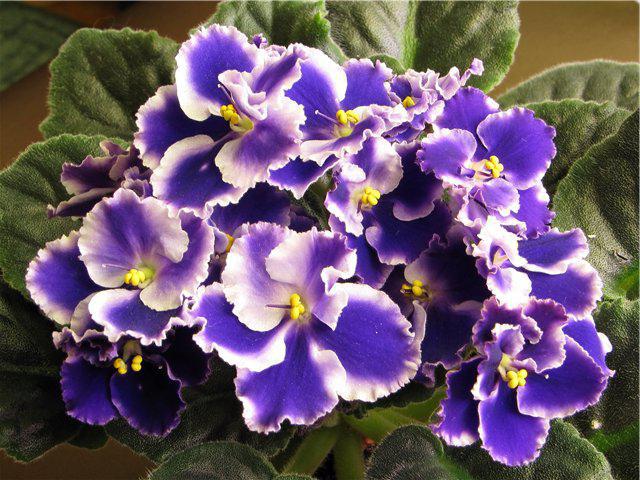Growing conditions
Like most hybrid varieties, "LE-Magenta" requires the creation of a number of favorable conditions necessary for its cultivation.
Location selection and lighting
The plant is quite demanding on light and prefers bright, but at the same time, diffused light. This requirement is due to the tenderness of the fleshy leaves, which receive extensive burns even with the slightest overheating. The duration of daylight hours for violets should be from 10 to 12 hours, therefore, in winter, especially in regions with short daylight hours, artificial lighting should be used. You can also place the pots on the sill on the south side, while controlling that the temperature on it does not drop below 18 °.
Thermal mode and air humidity
Violet "LE-Magenta" is a rather thermophilic plant and thrives at temperatures from 18 to 25 °. If the apartment is not very warm in winter and the windows face north, it is recommended to wrap the pot with a layer of foam plastic at least 2 cm thick.And it is also necessary to regularly ventilate the room, trying to prevent drafts. The optimum humidity for violets is 50-60%. Therefore, during the winter months, especially if the house has central heating radiators, you should use a humidifier or hang damp sheets and towels on the radiators.
Priming
Violet "LE-Magenta" grows well both in a special purchased soil, and in a substrate prepared by yourself. For its preparation, deciduous soil, peat, humus and sphagnum moss are taken in equal shares. The mixture is thoroughly mixed, fine debris and remnants of roots are removed from it and lumps are broken. The resulting composition should be loose and soft, without foreign inclusions and organic residues. Then the soil is poured onto a baking sheet and placed in an oven for disinfection. The procedure is carried out at a temperature of 200 ° for 20 minutes.
Pot
The variety grows equally well in both clay and plastic pots, so the choice of container depends on the personal preferences of the grower. A prerequisite is only the diameter of the pot, which for young shoots (children) should be at least 6 cm, and for an adult plant - from 8 to 12 cm. It is not recommended to plant a violet in a larger pot. This is due to the fact that until the flower grows a root system corresponding to the volume of the pot, it will not bloom. This usually takes about 2 years.
Violets on the windowsill | LE-Magenta (E. Lebetskaya);
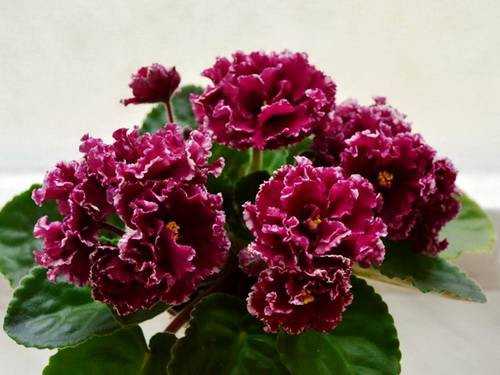

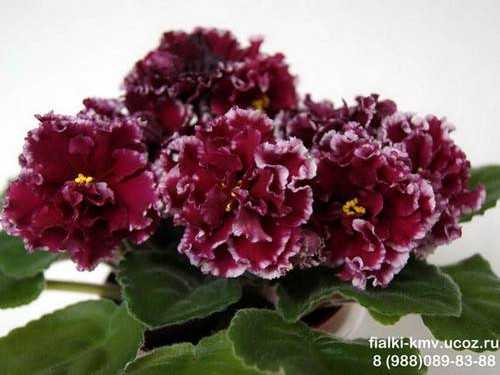
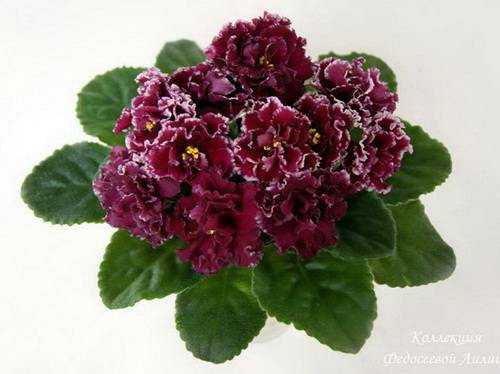

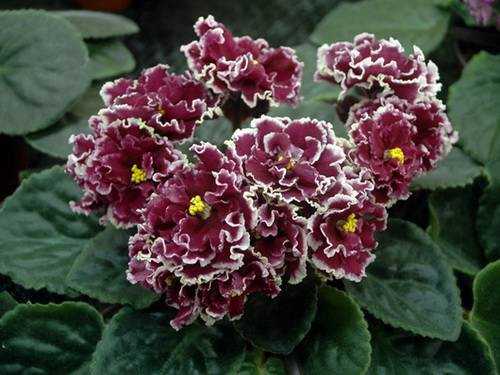
Usambara violet.
Family Gesneriaceae - Gesneriaceae.
Genus Saintpaulia hybrida - Hybrid Saintpaulia.
African violet saintpaulia hybrid.
Violets of breeders of the CIS countries - “M” (LE-2).
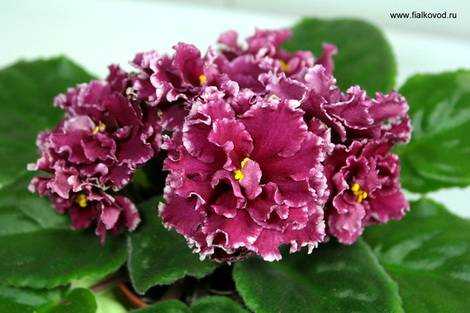
LE-Magenta (E. Lebetskaya).
LE-Magenta, LE-Madzhenta (E. Lebetskaya).
Very large semi-double and double stars of a rich red-beard color with a discontinuous white wavy border.
Pointed light large leaves with a silvery underside. With age, the leaves turn medium green and the inside of the leaf is slightly pinkish. Standard. The rosette is not very large, but loose, likes to grow long petioles.
Large semi-double and double flowers with a thin, sometimes intermittent white wavy border. The color is thick burgundy red. Very nice deep color, but not everyone likes the interrupted border on the edge of the petals. With each flowering, this variety increases the size of the border. This border does not always happen, at first the border is bright, then as it blooms, the border disappears. The color is bright red, becoming a very dark shade as they grow older.
Long-lasting and abundant flowering from the first flowering. The flower is 3-5 cm. It blooms for two months. Each peduncle has 3 to 5 flowers. Blooms for two months.The peduncles are long, the flowers are half-lying, if you start lifting, the peduncle breaks off.
Very picky about the quality of lighting, the variety needs a lot of light. Needs large and regular watering. It grows quickly, blooms early. Can sport, gives white and pink sport.
Magenta is a color term for a series of magenta colors. This color is purplish red, a combination of red and purple. The same word is also called a bright crimson dye, or fuchsin. In English, magenta is the common name for purple variants with a visible predominance of red, as opposed to the near-violet purple. The name of the color, or rather the dye, appeared for the first time after the Battle of Magenta (Italy 1859).
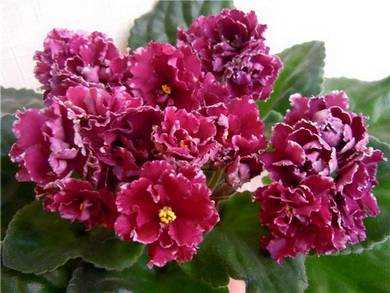
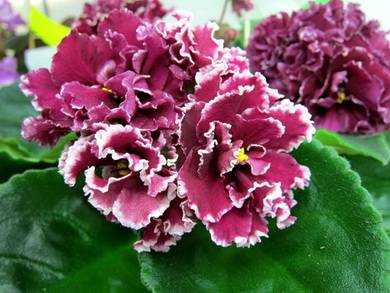
Do you know that…?
Do not use drugs of the first and second hazard classes in apartments. The toxicity of pesticide vapors in closed rooms is the volatility of the drug. Penetrating into the lungs of a person, pesticides are immediately absorbed into the blood, bypassing the hepatic barrier, spread throughout the body, immediately poisoning the brain and other internal organs. Any substance, even solid, can evaporate. The lower this indicator, the weaker the volatility, and therefore the less harmful the drug for the lungs.
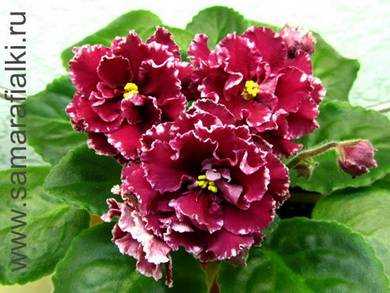

Before buying the violets listed below, carefully read their behavior on the windowsill on the forums. Many of them are very beautiful flowers. However, it can be large rosettes with large and fragile leaves, with leaves rising upward or hugging the pot, form many stepsons interfering with the formation of a neat rosette, pulls the stem up and grows into a herringbone, bending the trunk, rare flowering with long breaks, flowers that fall off or keep a little and wither quickly, very long and recumbent peduncles, the color of the flower quickly fades, they do not like bright lighting on the windowsill, they are afraid of the slightest drying out or waterlogging, a large percentage of sports or the darkening of the flower.
Are they suitable for your windowsill and the conditions you can create for them? You will be looking at flowers for several months, and the rosette is always in front of your eyes. There are many beautiful flowers, beautiful and neat outlets are much less, look first of all at the outlet! Search and you can find a dozen violets with the same color of flowers, if you are not interested in the smallest details, as a collector.
• - Maya Plisetskaya (Lebetskaya); • - Marina (Lebetskaya); • - Maslenitsa (Lebetskaya); • - Milady (Lebetskaya); • - Mirages (Lebetskaya); • - Mojito (Lebetskaya);
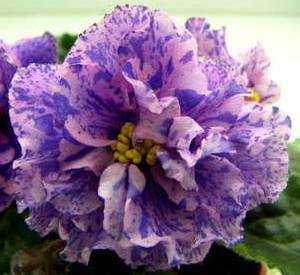
LE-Mosaic (E. Lebetskaya).

LE-Bronze Horseman (E. Lebetskaya).
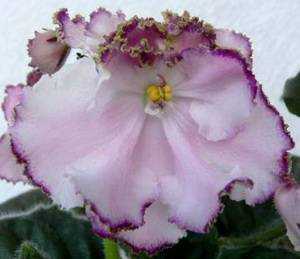
LE-Mont Saint Michel (E. Lebetskaya).
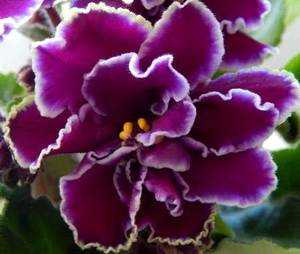
LE-Macho (E. Lebetskaya).
Continuation: Violets of breeders of the CIS countries - "M".
Continuation: Violets of breeders of the CIS countries - "M" (LE).
Continuation: Violets of breeders of the CIS countries - "M" (LE-3).
Continuation: Violets of breeders of the CIS countries - “M” (LE-4).
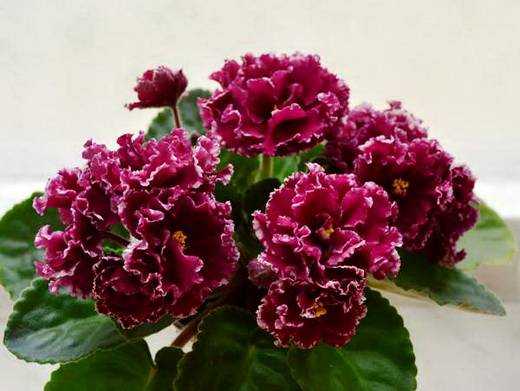
Reproduction
Theoretically, you can propagate Saintpaulia Magenta by seeds and vegetative method. In practice, only the second method is used in home gardening. If propagated vegetatively, then two options are applicable: by dividing the bush and by a leaf.
The division of the bush is used when the plant has bloomed.
The division technology is as follows:
- The bush is carefully dumped out of the container, the baby is separated with a sharp knife.
- The delenka is planted in a small, up to 6 cm in diameter, pot and covered with something, forming something like a greenhouse.
- Airing is carried out daily and watered in small portions.
- The mother bush is freed from dry parts and transplanted into a new pot.
The requirements for it are as follows:
- the sheet should not be old and not from the lowest row;
- absence of signs of disease on the material (suspicious stains, burn marks);
- The stalk should be healthy, and the plate should be firm and firm.
Further sequence of actions:
- The stalk is cut at an acute angle of 45 °.
- Rooted in boiled water, adding activated carbon, which will prevent decay.
- After the appearance of roots 1–1.5 cm long, the leaf cutting is transplanted into the ground.
- The cutting is deepened into the soil by no more than 1 cm, and if necessary, a support is placed for the leaf.
- Further care, as for an adult plant.
Did you know?The South Germanic tribes celebrated the first spring day when they found the first violet. And the lucky man or the lucky woman was promised a profitable marriage and prosperity in family life.
Possible growing problems
Each deviation in the growth of a violet means a specific problem. To prevent the development of negative consequences, it is necessary to study the main signs and methods of dealing with this or that case.
Leaf problems
Due to the lack of light, the leaves can fade and lose their elasticity. As a result of heat or too much light, the leaves may curl or lighten. Yellow and white spots appear due to drafts.
Pests
Among the dangerous pests are: root nematode and thrips. If insects are found, collect them and cut the flowers. Thrips damage the root system. The plant can be saved by mechanical treatment with insecticides.
Diseases
Diseases of violets Raisins include:
- leaf rot;
- the formation of gray rot;
- buds begin to wither without blooming;
- fusarium;
- late blight.

What does late blight look like in violets
Signs of improper care
Signs of improper care include a deterioration in the appearance of the plant. This can manifest itself in stunted growth, lack of flowering, leaf spots, rotting and the appearance of parasites.
DS Raisins are a bright and unusual variety of violets. The plant has the advantage of being easy to grow at home, as well as a long flowering period. The flower often suffers only due to improper care. Therefore, it is necessary to monitor the quality of the soil, fertilizing and lighting.
vote
Article Rating
Care rules
All varieties of violets are very thermophilic. They need to be placed in a place where there is a lot of light.
However, it is necessary to do this taking into account that direct sunlight does not fall on the flower itself, since in this case it can get burned. The optimum room temperature is 22-23 degrees.
It is worth watering the plants as the soil dries up, with clean water. Tap water must be allowed to stand in an open container for at least a day so that all chlorine evaporates. During watering, water should not fall on the flower itself.
In the event of a lack of light and water, the plant may deform, the shape and location of the flower itself will change.
Fertilizers should be bought in special stores, if you want to achieve abundant flowering, then they must contain phosphorus. The flower should be fertilized in the spring and summer, in no case should fertilizers be added in winter and autumn.
In this case, an additional load is exerted on the plant, instead of the prescribed rest.
Attention! It should be remembered that although violets love water and humidified air, however, you need to know when to water it. If waterlogging of the soil is allowed, the plant will die.
Seat selection
 Although the violet is an unpretentious plant, in order for it to please with a healthy look and flowering, it must be placed in the right place.
Although the violet is an unpretentious plant, in order for it to please with a healthy look and flowering, it must be placed in the right place.
Since this flower is very fond of sunlight, it should be placed on a windowsill in the western or eastern part of the house.
In this case, it must be placed so as to protect it from drafts.
If it is impossible to provide sufficient lighting, you can use a special lamp for 12-14 hours. Those. organize additional lighting.
Pot selection
When choosing a pot, you need to consider why you want to transplant. If the plant has become cramped, the roots have filled the entire volume, then you need to choose a container of a slightly larger size. If you just need to renew the soil, then a large pot is not required.
With a large amount of free space, the root system begins to actively develop, and the plant stops blooming.
If you want to achieve flowering, you should focus on a pot with a diameter of about 5-7 cm.When choosing a plastic pot, it is worth checking if there are drainage holes in it that will allow the roots to breathe and drain excess water
The plastic itself does not allow air to enter the pot
When choosing a plastic pot, it is worth checking to see if it has drainage holes that will allow the roots to breathe and drain off excess water. The plastic itself does not allow air to enter the pot.
Attention! When transplanting violets from one pot to another, it is worth considering that the new pot should be slightly larger than the previous one.
Soil selection
When choosing a soil, you need to pay attention to its quality. It should contain all useful trace elements and be loose enough.
When transplanting, you should not use the soil from the old pot, since most likely it is completely depleted and will not be able to provide the flower with food.
You can use homemade mixtures as a soil for a flower.
But the easiest way is to purchase primer in a specialized store.
What does a violet Raisin look like
The Raisin variety belongs to the Violet genus and the Violet family. There are more than 600 species of this plant in the world, but even against their background, Raisins can surprise.
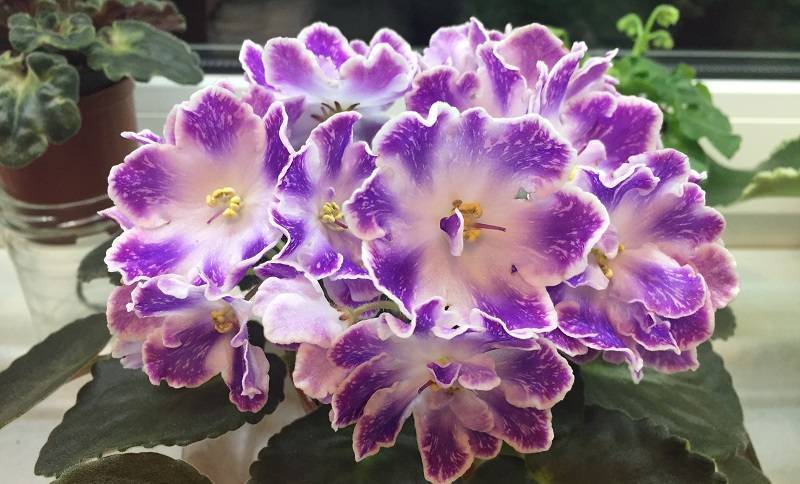
Violet Raisin with variegated flowers
Violet Raisin or DS-Raisin has a very memorable appearance due to its unusual inflorescences.
The compact bush has a height of 30-40 centimeters. The leaf plates grow directly from the root rosette and are tear-shaped. Their surface is smooth, and the color is solid dark green with no blotches or light areas or veins.
Violet DS Raisin was bred by crossing varieties found in the late 19th century by a British baron who traveled through eastern Africa. Breeders made many different hybrids of these flowers in the middle of the 20th century, the most beautiful of which was the violet DS Raisin.
It is interesting! Among some plant lovers, there is a belief that in Latin, violet is written as "fialka". In fact, this is not so - in the west they are called Saintpaulia (Latin Saintpaulia).
What is sport for fantasy Saintpaulias
You can often hear the term "violet sport", what does it mean? There is nothing complicated in this word, this is the designation of varieties that, over a long time of their cultivation, have managed to lose the properties and characteristics of their ancestor variety. As a rule, such flowers can already be called a new subspecies of violets.
Leaf sport
Leaf plates can undergo noticeable changes in shape and color. This is influenced by the conditions of the bush, the method of its propagation, the quality of fertilizing and the pH level of the soil.
Flower sport
Violet sport undergoes noticeable changes in the characteristics of its colors. Due to genetic mutations and the effects of certain external factors, the color and shape of the inflorescences can completely change. The ancestors of Izyum had a solid lilac color, and the current plant has left this external resemblance to a small extent.
Planting and grooming recommendations
Violet is not a very whimsical plant, however, it is recommended to follow certain rules for growing. In the garden, some species of wild Saintpaulias can survive on their own, but in most cases, do not forget about proper care.
Soil, illumination, degree of moisture, planting capacity
Violet loves light, but the sun is harmful to her, as brown spots may appear on the leaves, the plant will begin to fade. You will have to learn how to disperse the sun's rays or not put the flower on the windowsill on the south side of the house.
At home, Saintpaulia should grow at a temperature of 18-26 ° C. Sudden changes in temperature and drafts are harmful to her. Watering is recommended to be carried out with water settled for 1-2 days in the plant tray. Watering is required 2-3 times a week.Air humidity should not fall below 50%.
Important! The soil for growing a plant must be moisture-retaining, loose. The components most often choose a nutrient medium, coniferous or peat filler, sphagnum moss, expanded clay. It is recommended to plant violets in plastic pots with drainage holes
Planting violets in plastic pots with drainage holes is recommended.
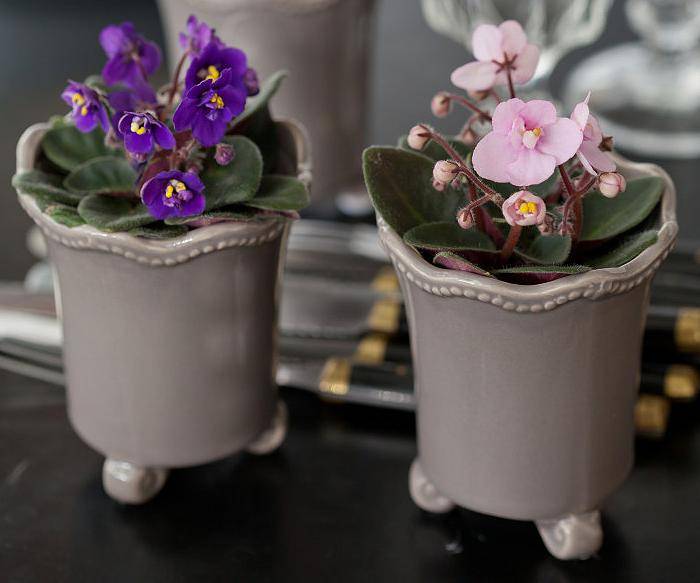
Suitable pots for violets
Note! Any changes in temperature are harmful to the plant in the same way as the sun's rays. The plant should not be placed on a windowsill, under which there is a switched-on central heating battery. Also, the violet is picky about the soil in which it grows
If you fill the plant with water, fungal diseases can appear in it.
Also, the violet is picky about the soil in which it grows. If you fill the plant with water, fungal diseases can appear in it.
What does a violet Raisin look like
At the moment, more than 30 thousand subspecies of this bright flower have been bred. Breeders are not satisfied with what has already been achieved and are working on obtaining new violets of unique colors.
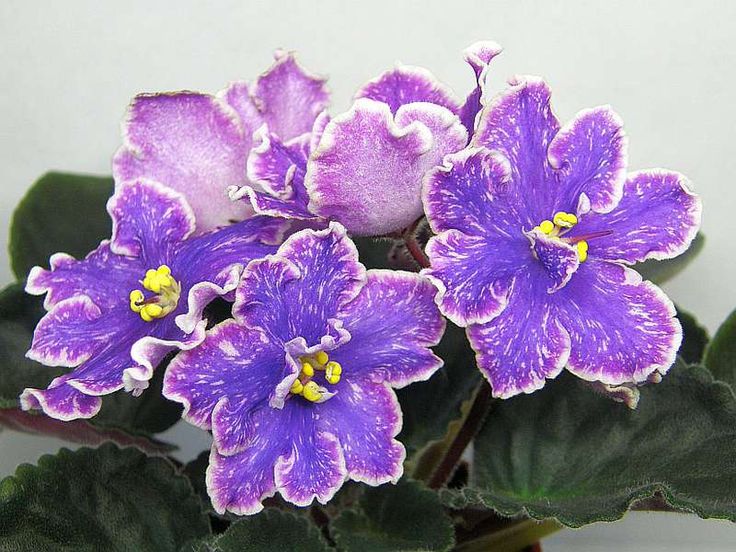
Abundant bloom of violets Raisins
For your information! The prefix DS in the name of the variety means Dimetris, that is, a selection of various colors bred in the work of one breeder.
Plant characteristics
Violet Raisin is a multi-petal plant of a delicate lilac hue. Standard size green leaves. A white border frames the edges of the petal. The amount of white will depend on the environment when setting the bud.
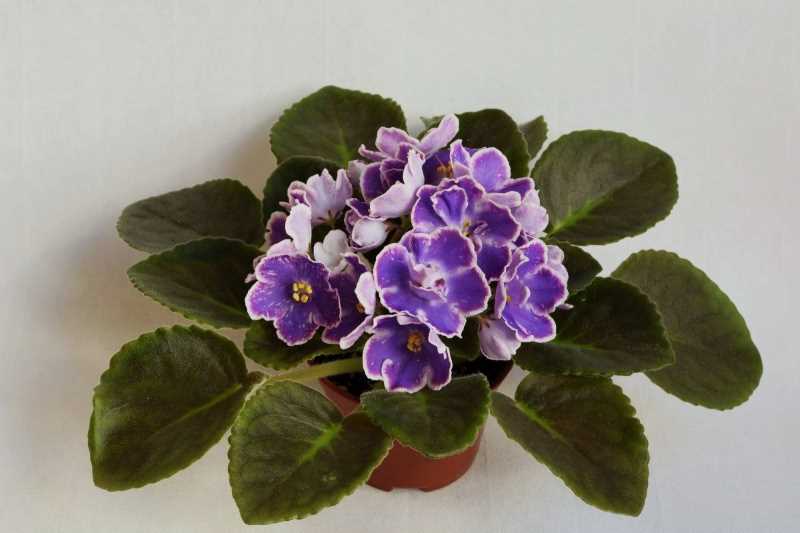
The peculiarity of the plant is a miniature and compact rosette
What family does it belong to
Violet DS Raisin belongs to the Gesneriev family. In fact, these flowers are not violets, however, the long-term cultivation of these plants and external similarities have led to the fact that they are still called so.
Briefly about the history of appearance
The ancient progenitors of the Raisin species were first discovered in 1881 in East Africa. For a long time, the variety was grown in two variations: purple and blue.
In the middle of the 20th century, breeders began to combine different varieties of this species. The result is a new variety of violets. Legends of Ancient Greece are associated with the appearance of this flower. One of them says that a forest nymph was turned into a violet, who was languishing in the heat and asked for salvation from Zeus. He saved the girl from the heat and turned into an unusual flower.
Soil selection
If we talk about soil, then it is easiest to buy it in a specialized flower shop. However, some experienced flower growers do not trust the factory formulations, and prefer to prepare the soil with their own hands. This requires:
- Lay drainage on 1/3 of the pot (for this you can use charcoal, brick screening or construction expanded clay).
- Fill the container with light, nutritious and breathable soil. To prepare it, you can mix simple earth with leafy humus, turf soil, rotted manure and vermicompost. To make the soil soft and breathable, you need to use peat, light garden soil or sphagnum moss. Quartz sand or vermiculite is also suitable as a baking powder.
Transfer
Transplant of violets Humako happens:
- planned, when the soil in the pot is depleted, it is changed to a new one. Do it every 2 years. The pot is selected the same size. If the plant is healthy, the procedure is carried out by transshipment with an earthen clod. You first need to do drainage at the bottom of the pot. It should occupy half of the flowerpot;
- unscheduled when the plant is sick. Then they shake off the old earth, examine the roots. Blackened, rotten ones are removed. Pour in new soil from the store, or prepare the soil mixture yourself.
The flower does not suffer during transshipment. Carry out a planned spring, unscheduled as needed. Before transshipment, the plant is abundantly moistened.
What does the violet Humako inches look like?
The humble commandant of the Usambator District of Tanzania immortalized his name when, in 1892, he discovered a blue-purple flower in a crevasse in a rock. V. von Saint-Paul collected seeds, from which a year later G. Weldland, a botanist and florist, grew an indoor flower. In the description, he gave him the name Saintpaulia violet, or violet-flowered, and singled out it as a separate genus.

White violet Humako inc with purple border
For your information! In everyday life, the plant is called the usambator violet at the place where the flower was found. Outwardly, it really looks like a viola.
Flowers belong to the Gesneriev family. In nature, the plant reaches a height of 30 cm. At home, the Humako violet is inches smaller.
Leaves are light green, fleecy. The shape is rounded, sometimes oval, slightly pointed at the ends. Flowers are collected in a root rosette measuring 7-10 cm. A large rosette is made more compact when the petioles are not allowed to grow in length, they are cut off.
The flowers are large (up to 8 cm) white with a blue center. They consist of five elements, the inflorescences are collected in a brush. In double and semi-double varieties, the number of petals increases. Lush flowering, flowers completely cover the rosette.
They can be wavy at the edges. It is a separate variety that is difficult to grow commercially as it cannot tolerate transportation. Therefore, it grows only among collectors. They call the twin variety Humako inches 2.
How to properly prune a bush
In order for the violet to be even and symmetrical, it is necessary to shape it periodically. It must be remembered that the rosette of the plant should consist of 3 rows of leaves. If there is a bunch of leaves in the center, then the flower will not form correctly, but will begin to grow in all directions.
First of all, you need to get rid of yellowed and diseased foliage. In order to properly separate it from the trunk, you need to grab the sheet with your thumb and forefinger and press your fingernail on the base. After that, it is enough to separate the unwanted vegetation element with twisting movements.
If after cutting the bush the trunk of the violet looks bare, you need to bury it a little in the ground.
When and how it blooms
The violet often blooms for most of the year. First of all, this process depends on proper care, watering and lighting.
Types of flowers
During the flowering period, brushes of 6-9 blue-violet flowers appear on the outlet. White or pink stains are visible on the petals. Sometimes there are specimens with pale crimson flowers, which are divided by white and blue areas. The center of the flower is snow-white.

Inflorescence diameter from 4 to 7 cm
Standard shape with wavy edges and light edging. Flowering peaks in the spring, from March to May.
Changes in care during flowering
There are no specific changes in care during the flowering period. It is necessary to adhere to the usual scheme and provide optimal conditions for the plant. In this case, the violet will fade and immediately release new buds.
Classification
All varieties of terry violets can be conditionally divided into groups according to several criteria. For example, depending on the degree of terry, there are two main groups:
- Terry;
- Semi-double.
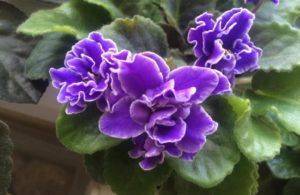 In the photo you can see a terry violet. Also, there is a division into groups, depending on the appearance of the Saintpaulia inflorescence:
In the photo you can see a terry violet. Also, there is a division into groups, depending on the appearance of the Saintpaulia inflorescence:
- Pectinate;
- Carnation.
The colors are distinguished:
- Light terry violets;
- Dark terry varieties.
IMPORTANT! Violets of several colors, conditionally form separate groups of terry Gesneriaceae. The first includes red, pink and raspberry saintpaulias. The second is formed by plants with blue, blue and gray flowering.
The second is formed by plants with blue, blue and gray flowering.
Among the bright representatives of terry, in particular, there are varieties:
- Atlantis;
- Bridal bouquet;
- Lyubasha;
- And also a few others.
Dark Saintpaulias are adequately represented by Chateau Brion and Gift for a loved one.
 Most often, on the windowsills of avid florists, you can see Saintpaulias with a simple type of terry. These plants differ from all other types:
Most often, on the windowsills of avid florists, you can see Saintpaulias with a simple type of terry. These plants differ from all other types:
- Leaf shape (round soft dark green leaves);
- And also the structure of the flower of the plant.
In representatives of the genus with a simple type of doubleness, the corolla consists of 4-6 petals.
Flowers with the so-called scallop degree of doubleness, as a rule, have at least 6 petals in the corolla of the flower. More often, the number of petals of such a plant can be at least 8-9 pieces.
One of the most famous scallop varieties is the Gift for a loved one. It is also distinguished from other terry varieties by the shape of the petals. The fact is that in plants with this type of terry, the top of the flowering has a wavy shape with a fringe over the flower.
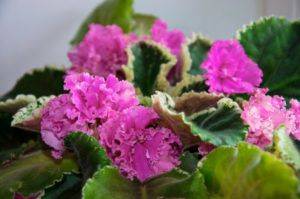 Semi-double flowers are recognizable:
Semi-double flowers are recognizable:
- By the shape and color of the leaves (round or oval, velvety, light green);
- And also by the number of petals in the flowering rosette (from 6 to 9).
In turn, terry saintpaulias have 10 or more petals in the flower rosette.
As for such a degree of terry as a carnation, such varieties have an incompletely open rosette with semi-double petals.
ATTENTION! The shape of the flowers of such violets resembles the flowers of a carnation, which is where their name comes from.
Which pot to plant
Violet Raisin, a photo of which demonstrates its main advantages, needs to be properly planted. Usually plants of this species are planted in small pots (5-7 cm in diameter). If you plant Saintpaulia in a very large container, then it will not look very beautiful. In addition, too large a pot will lead to the fact that the plant will actively grow, instead of blooming.
If you really want the bush to be large, then it should be borne in mind that in such conditions the first flowers on the violet will appear no earlier than 2 years later.
The roots of this plant are quite close to the surface, so a large pot is not required.
If we talk about the container material, then it is best to use plastic or ceramic pots. The former are very cheap, flexible and durable. However, these pots do not allow the plant's roots to breathe. Therefore, a plastic container is worth buying only if it is sold with a special pallet with a ribbed surface. This will allow air to flow to the root system through the drainage holes.
Also very beautiful glazed pots are often found on sale. They have the same disadvantages. The best pots are ceramic. Violet DS-Raisin, the photo of which is presented in the article, feels best in such conditions.
